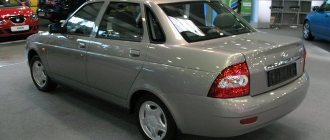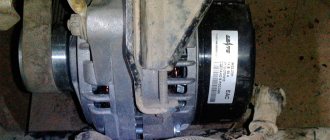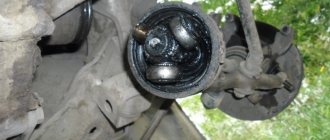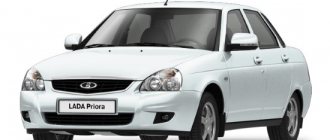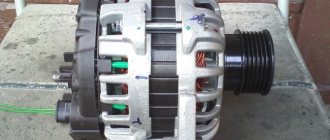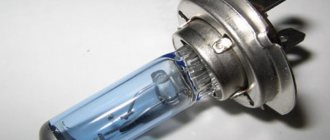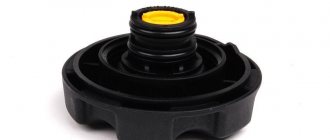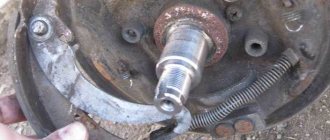Facelift
On the training ground we looked like children looking for differences in two seemingly identical pictures. So, looking back at the pre-restyling car, which we immediately dubbed old, we begin to bend our fingers, counting the updates. The front bumper, which appeared on the model last year, has not changed, so at first glance both Prioras appear the same.
The only difference is the plastic radiator grille - the new honeycomb structure has refreshed the exterior. Although at a distance the honeycombs still need to be seen. The headlights are the same. I agree with the opinions of the owners on numerous forums: they work as they should.
In the stern, the main focus is on the lights. Now in their lower part there are LEDs, which are longer lasting than ordinary lamps that are on a white car. Larger reflectors on the bumper also help to outline the dimensions. At dusk, the new lighting technology really showed itself better - it was noticeably brighter.
Dimensions of VAZ 2170 and other modifications of Priora
The dimensions of the car are something that needs to be taken into account when purchasing, since the dimensions of parking spaces, garages, turns or entrance arches are not always universal. The height is measured from the extreme point of the front to the extreme point of the rear bumper. The width is measured at the widest point, and the height is measured from the surface of the ground to the highest point of the roof. Roof rails and racks do not fit into the height of the body. Taking this into account, the dimensions of the Priora are as follows:
- The longest body of cars in this family is the sedan. It measures 4350 mm in length. But at the same time it is the lowest - 1420 mm. in height.
- The next longest is the station wagon, with its 4340 mm length. It is the highest in height – 1508 mm.
- The five-door hatchback and three-door coupe are the shortest - 4210 mm. at 1435 mm. in height.
In all four cases, the width of the Priora is the same - 1680 mm. Ground clearance is 165 mm, although in the Priora Sport configuration it is somewhat reduced, but this is no longer so important, since this car is no longer produced in this version.
Anti-aging treatments
As soon as you start the engine, the new car’s low beam headlights flash, even if the switch is in the “0” position - convenient. The indicator squeaks to warn you that your seat belt is not fastened, and when you lightly touch the steering column, the turn signal flashes three times.
I turn on the side lights sequentially, then the headlights... Not one icon appears on the instrument panel, like in an old car, but two. It’s a small thing, but now you don’t have to guess what lighting equipment works.
The new instrument panel is more interesting in terms of design. In general, there were no special complaints about the previous one, but it was too simple and had already become familiar. And then there were the wide white arrows and well-arranged pictograms, and I immediately fell in love with the new product.
The updated dashboard not only refreshed the interior, but also added convenience. The on-board computer screen was placed in the center. There is no unnecessary beauty on the monitor, everything is simple, but large numbers are clearly visible in motion.
The driver's position is praised by many owners, but being 190 cm tall, I feel uncomfortable in the seat: there is very little space in the area of the pedal assembly of the old car, and there is not enough longitudinal adjustment of the seat. The updates have corrected the situation a little: the seat slides in the new car have been lengthened, so you don’t have to lean the back too much back.
The chair is denser, it better fixes the body in turns. The distance between the gas and brake pedals is noticeably greater. Having adjusted the driver's seats in both cars, I tried to sit back and couldn't. The backs were too close to the rear sofas. And if four people get into the car, I, the driver, will have to press my knees to my ears.
Advantages and disadvantages of Lada Priora
Among the advantages are a largely updated appearance, bright modern headlights, a functional dashboard, high-quality finishes, and more reliable engines. Sound and noise insulation has been significantly improved.
The developers paid special attention to the security system. The results of the tests confirm that the work done was not in vain. All models are equipped with driver airbags, and the body is designed to meet modern passive safety requirements.
There are also some disadvantages. First of all, unstable engine operation, loss of power. Sometimes the engine does not start. The causes of such failures may be problems with the level of fuel pressure, malfunction of the timing belt, faulty sensors, or air leaks through the hoses. As with previous models, the components supplied to the assembly line are not always of high quality.
You can also note the possibility of failure of the electric amplifier, most often this happened in cars of the first series. This is due to imperfect design. The malfunction is corrected under warranty service
Color change
“First impressions: the car needs to be rolled out, it doesn’t drive. There is no sound insulation, locks and door handles require improvement. The standard tires are noisy and dull. You’re riding like you’re on stumps.”
“In two difficult months, the car covered 18,000 km, but did not cause any problems. The chassis, in my opinion, is quite tolerable, the only thing is that a knock is heard in the right pillar when passing speed bumps. I came to the service, looked at it - everything is fine, they say it’s their illness. The brakes are not bad, 4"...
I compare the impressions of Moscow Prior owners with my own. The cars have the same 98-horsepower engines, so there are no fundamental differences in movement. The suspensions regularly absorb large bumps, but shake on small bumps. However, the gray car is more interesting at the level of nuances: it is more composed in corners, a little more stable on the way out, and absorbs road bumps more smoothly.
In terms of acceleration dynamics, the new and old “Priors” are practically no different from each other, while a noticeable monotonous rumble fills the interior. I remember that during our first meeting with the car they told us about improving the sound insulation. We measured the noise level in the cabin (both Prioras were shod with the standard Kama-Euro) and were surprised: the new car turned out to be not as quiet as the previous version! The reason was found in the trunk: it turned out that the carpet in the pre-restyling car was thicker.
The steering is equally uninformative, and the updated car has a sharper steering wheel only in the Lux. We are waiting for him in other modifications.
“The transmission works fine, except for first gear. I switch to lower with effort. This happened to me on all Zhiguli cars, from the “six” to the “ten,” - I continue to study the forum of Prior owners.
The white Priora has a similar behavior, but here the fifth gear is difficult to engage. I push the lever by force, and it doesn’t work the first time. In a restyled car, it is more convenient to operate the lever. New cable driven unit? Unfortunately, no: both have well-known boxes with the VAZ-2112 index, which my colleague was not enthusiastic about when he tried out the new Priora in Tolyatti. Therefore, they decided: these are the features of specific machines. I would like to believe that the better performance of the transmission is evidence of improved build quality. By the way, when the engines are idling, the gearbox levers of our pair vibrate equally strongly.
Market bestsellers. Lada Priora: at the end of history
Ten years ago - in March 2007 - AvtoVAZ started production of the Lada Priora passenger model, the successor to the history of the "ten". First of all, a sedan appeared, then a hatchback and a station wagon. The family had the honor of testing out some new technical solutions for the brand and entering the top of the national popularity ratings. But since 2015, degradation began: today the line has been reduced to the original sedan with a limited choice of versions, and next year, 2022, the production of this model will cease. It so happened that the development of production at AvtoVAZ was based on a completely different “seed” fund. Nevertheless, Lada Priora was and remains a noticeable phenomenon among Russian economy class cars.
Are the differences great?
If we recall the chronology of events, the Lada Priora family, even at the prototype stage in 2003, was promoted with the goal of correcting (or correcting) many of the shortcomings of the “tenth” family - from design to driving performance. According to the manufacturer, more than a thousand changes and improvements were implemented on the existing platform, and much more was done during the serial production process in subsequent years.
Pre-production Lada PrioraIn its main body, the Lada Priora sedan now occupies an intermediate position between the Lada Kalina/Granta and Lada Vesta. With a length of 4350 mm, a width of 1680 mm, a height of 1420 mm and a wheelbase of 2492 mm, the car belongs to the so-called B+ segment. The trunk with a capacity of 430 liters also fits within the class limits.
The outlines of the “ten” were visible mainly in the central part of the body, while the new wings, bumpers, hood, trunk, lighting, although they did not make the car completely different in appearance, did evolutionarily transform the appearance of the successor. Of course, it turned out ambiguous and not indisputable. To some, for example, the big-eyed cladding seemed inappropriately feminine and naive compared to the prickly narrow cut of the predecessor's headlights. But the main thing is that the light of the new headlights turned out to be effective. The front panel of the cabin has changed: instead of the “ten” underground, a more traditional structure for mass models has appeared. Despite its Italian origin (Carcerano studio), the panel was simple in appearance, but made using higher quality “grades” of plastic. True, this circumstance did not eliminate the problem of squeaks in the cabin, and the comfort of the “loose” seats did not add optimism to many owners.
Sales of LADA Priora
To begin with, some indicative figures from the biographical dossier. From 2009 to 2012, Lada Priora occupied exclusively the top positions in the sales list. The peak of fame came in 2011 - a record 138,697 copies were sold (according to AEB data), which ensured second place in the overall standings (the current leaders are oh so far from such indicators). In 2012, the model topped the list, but already with a result of about 126 thousand cars sold, and the next year there was an incredible retreat to eighth place with a result of just over 57 thousand cars sold throughout the country (a reduction of more than two times). Moreover, at this time there was a restyling and further modernization of the model. But this did not save it from inevitable collapse - ninth place in 2014, then 13th, and in 2016 - a complete rollback to 23rd place with a modest 17 thousand cars sold.
As one of the most popular Tolyatti models, Lada Priora has become a common (and even cult) object for various types of modifications and tuning. Ranging from typical design improvements (or fixes) in terms of ride quality, sound insulation, door seals, body corrosion protection and interior comfort, to major changes in engineering and styling (Stance and Rat Look). Many experiments border on vulgarity, but we must pay tribute - there are also very demonstrative projects with a large budget and high quality of execution
A certain step forward was made in terms of equipment, since initially all Priors were already equipped with at least a driver’s airbag as standard, and electric windows and mirrors, heated seats, air conditioning, armrests, remote control key or electric trunk lock were by no means exclusive to luxury versions. The conservative power steering was still present, but it began to be replaced by the fashionable electric power steering. At first, it did not work without whims, but then it gained the trust of the owners, who ultimately found it more convenient and less whimsical (no need to monitor, it does not leak, etc.).
Having started production of the Lada Priora in 2007 with a sedan (VAZ-2170), AvtoVAZ followed with a 5-door hatchback (VAZ-2172) with the same set of engines. And only in 2009 a station wagon (VAZ-2171) appeared with a number of original solutions. It was distinguished by an increased body height (1508 mm including roof rails), vertically shaped rear lights and rear side windows with “cut off” corners. The engine was initially offered only with a power of 98 hp, and with the 2013 restyling, a 106 hp version was added to it. In addition, in 2010, the family was expanded with a three-door hatchback, whose status was higher. The car was given the name Lada Priora Coupe: the body consisted of about 150 original parts, and the coupe was produced in a small series at the facilities of AvtoVAZ Pilot Industrial Production in the most expensive Luxe and Sport trim levels. In just 5 years of production, about 2,500 copies of Priora Coupe were assembledOn the engine side, a special feature was the use of only 1.6-liter engines, although at first the well-known fuel-injected 1.6-liter 8-valve engine with a power of 81 hp was offered in the basic version. with good throttle response: the maximum torque of 120 Nm was achieved at 2700 rpm. And yet, it was not he who determined the main power portrait of the car for many years of production.
The front part of the interior of the “first” Lada Priora is not without some zest - there is an analog clock on the center console and chrome inserts. The climate control unit with round knobs and an informative instrument panel is located at the bottom
Progress consisted of the appearance of a new VAZ-21126 engine with a power of 98 hp. (at 5600 rpm) and a peak torque of 145 Nm at 4000 rpm. Such an engine endowed the Priora with more lively dynamic qualities: acceleration to “hundreds” in 11.5 seconds, but most importantly, with an obvious reserve of power at high speeds. At the same time, under normal driving conditions, the engine had a small appetite: in highway modes, the actual consumption could not exceed five liters, in mixed modes - six to seven liters.
The hallmark of the Lada Priora family is the 16-valve 1.6-liter engine producing 98 hp. (VAZ-21126), with which an economy class car became dynamic and economical in a modern way. But the owners were faced with problems with the quality of components and some design flaws. Thus, the thermostat was capable of unexpectedly jamming, and in the closed position, oil could penetrate into the spark plug wells due to an unsuccessful seal of the cylinder head cover, and the heavily “sweating” upper hose of the crankcase ventilation system is an integral “stain” (albeit removable) almost all carsTrue, the overall picture of the “combat” power unit was spoiled by new operational realities. The two-shaft 16-valve cylinder head with a belt drive did not exclude premature breakage of the belt, for example, due to a jammed pump or tension roller, and such an event led to the meeting of the valves with the pistons and a rather expensive repair (25 thousand rubles or more). The belts themselves were not always able to “nurse” for the required period (at least 100 thousand km). The design of the timing belt includes hydraulic valve lash compensators, so there was no need to once again “climb” into the engine for adjustments. But the expansion joints themselves could become the reason for expensive repairs: it was possible that one or more could become stuck and require replacement, even with timely maintenance using high-quality oil.
The engine is not complicated by systems of variable valve timing or direct fuel injection, but even without that it cannot be called simple compared to its predecessors. First of all, on the electronic part: there are about a dozen sensors in the control system alone, as well as four individual ignition coils, electronic throttle control, and even such exotic things as the solenoid valve for purge the adsorber - a component necessary to meet increased environmental standards.
The sedan's trunk with a capacity of 430 liters is quite enough in most cases, even if it is somewhat squeezed by the wheel arches. There is a hatch for long items and a folding backrest. But there is also a structural problem - water getting into the side niches, presumably through ventilation windows and unsuccessful seals. I reacted simply - I made “drain” holes with plugs. Some car owners remove these plugs altogether - in this case, water penetrates from below, but the drainage is “automatic”In general, the Priora’s rich electronics were not without annoying “glitches,” and replacing some sensors with new ones did not always lead to a positive result the first time - the reason for this was defective spare parts. There are even cases of owners using “non-native” components, for example, when a capricious temperature sensor is replaced with a sensor from a Japanese car. In a number of cases, a malfunction “out of warranty” is eliminated at no small cost: for example, replacing a mass air flow sensor will cost around 4,000 rubles.
Taking into account the class, the Priora's interior is not distinguished by a generous supply of space, especially for tall people. However, before the modernization, complaints were limited to the comfort and durability of the seats, which was expressed not only in the use of covers, but also in the replacement of the driver's seat and even the rear sofa cushion
In addition, not everything turned out to be in order purely on the mechanical side. The fundamental design of the suspension remained the same, which was based on the “Soviet” development for the VAZ-2108. In front is a McPherson strut with shock-absorbing struts, forged wishbones, diagonal braces and a stabilizer bar attached to the arms through short “links.” The rear suspension is semi-independent, with a torsion beam. The main differences were different characteristics of shock absorbers and springs, as well as a stiffer anti-roll bar. All these alterations made the Priora chassis more compact, but with some damage to comfort. However, within the framework of individual operation, the owners could change the damping and other properties of the chassis in any way they wanted, for example, by selecting certain shock absorbers, springs, changing the stabilizer mounting pattern and similar tuning tricks.
Safety
In fact, Lada Priora entered the market in a “raw” form and was supposed to be improved during mass production, moreover, in the area of such an important component as passive safety. This is evidenced by an independent crash test conducted by Autoreview magazine using the EuroNCAP method - with a frontal impact at a speed of 64 km/h on a crushed barrier with an overlap of 40%.
According to the test results, sedans produced in 2007 could only qualify for two stars out of five: in terms of points scored (5.7 out of 16 possible), the Priora differed little from the VAZ-2110 (4 points) and Kalina (5.6 points). And only the “Lux” version with a reinforced body, two front airbags and seat belts with pretensioners showed higher protection for the driver and passenger - 10.56 points. At that time, this corresponded to three stars according to EuroNCAP and was approximately equal to the safety level of such foreign classmates as Renault Logan (12 points) or Chevrolet Lanos (10.5 points). In the first half of 2008, AvtoVAZ completed the modernization of the Priora body for all versions: with the introduction of more than 30 new reinforced elements (engine shield, A-pillars, roof, door bars, etc.), however, only one frontal one remained in the basic configuration airbag.
Restyling and lost opportunities
As mentioned above, various changes and improvements were made to the Priora’s design after the start of mass production, but the most noticeable transformation took place in 2013–14. The car received rear lights with LED sectors, an updated interior with a modified front panel and multimedia system, ESP, a VAZ-21127 engine with 106 hp, as well as a modified manual transmission with cable drive.
Restyling 2013. Changes in details have modernized the front panel, primarily due to a different design of the instrument panel and a different configuration of the center console, which is crowned with a larger multifunction display
Initially, the gearbox of the 2180 Priore series was inherited from previous generations of front-wheel drive VAZ models. That is, a unit with an outdated drive through rods with a lower location of the gear selection mechanism inside the housing. If the “howling”, vibrations and “looseness” of the lever were tolerated as inevitable, then oil leaks through the joint or oil seal of the rod “bothered” the owners of the first Priors quite a lot. Since 2012, the AvtoVAZ model range begins to try on the 2181 series gearbox - with a cable drive, a new gear selection mechanism, improved synchronizers and a number of other changes. Of course, Priora also got involved in this reform process; moreover, the model became the debut platform for the introduction of a functionally different transmission unit.
Today, AvtoVAZ’s experimental “bins” contain a copy of the Lada Priora station wagon with all-wheel drive and an inter-axle viscous coupling. Priora 4×4 could have taken on the mission of the first all-wheel drive station wagon from AvtoVAZ, but it remained a prototype.
In 2014, Lada Priora makes a small “robotic” revolution, becoming the first production model of the plant with an automated manual transmission of its own design (VAZ-2182). Before this, another model - Lada Granta - was already widely sold with a Japanese hydromechanical “automatic”, but for Priora they prepared something simpler, more accessible, economical and almost “our own”. Although, for reasons of prestige, the “robot” was installed only with the most powerful (and expensive) 106-horsepower engine.
The new unit was based on a modernized 5-speed gearbox with one clutch, which included an electronic control unit, a pair of electromechanical drives (gear selection mechanism and clutch) from the German company ZF and, of course, a different selector
In principle, the VAZ “robot” repeated the design of inexpensive foreign “colleagues”, previously known, for example, from Peugeot passenger cars. The main part of the box can be repaired like a regular “mechanics”, but the imported mechatronics are “declared” maintenance-free, its service life is declared (but not guaranteed) for ten years, and in case of failure, the entire unit is replaced. The VAZ “robot” was only 5 kg heavier compared to the original “mechanics”, did not require chassis reconfiguration and was easily adapted to other factory models. Actually, Priora remained in the role of a “launching pad”, since in the future, all the pleasures of the “robot” were mainly enjoyed by the buyers of Granta, Kalina and Vesta.
Options, prices
At the end of 2015, the Lada Priora line lost its hatchback and station wagon, and since 2016, the family has been offered in a greatly reduced and simplified form - options with an automated manual transmission have disappeared and the basic version with an 8-valve engine has returned. Today, the offer opens to a “forgotten” version with an 87 hp engine. in the Standard configuration - for 400,000 rubles. This price includes an airbag for the driver only, ABS, emergency brake assist, daytime running lights, electric power steering, trip computer, cabin air filter, front and rear armrests, height adjustment of the steering wheel and driver's seat, and electric front windows.
According to many, it was in the station wagon body that the Lada Priora acquired its most correct and harmonious forms. With a length of 4340 mm and a minimum trunk volume of 450 liters, the station wagon has become the most spacious and practical option in the line of budget cars for cargo and passenger transportation. If the car (or rather, its buyers) had been a little more lucky, then an all-wheel drive version would have gone into production!The remaining four versions are still equipped with a 106-horsepower engine and only a manual transmission. This is the Norma version (security alarm, engine protection, 14-inch wheels, remote key, electric and heated mirrors) - 440,600 rubles, the Norma Climate version (climate control, heated seats) - 481,000 rubles, as well as a couple of “image” » White Edition and Black Edition. In the latter case, the cars are equipped at the Norma Climate level with additional 15-inch alloy wheels and in the corresponding body color. Prices in both cases are 500,000 rubles.
Estimated cost of some standard spare parts and units for Lada Priora (in rubles)
| Engine VAZ-21126 (98 hp), without attachment/assembled | 60 000/87 000 |
| Cylinder head assembly (engine VAZ-21126) | 23 000 |
| Mass air flow sensor | 3400 |
| Speed sensor | 900 |
| Clutch assembly | 3200–4300 |
| Drive assembly | 3700–5100 |
| CV joint, outer | 1600–2250 |
| Front shock absorber strut | 2100–2600 |
| Upper rack support | 1200 |
| Front spring | 1100 |
| Rear shock absorber | 1300 |
| Headlight assembly | 4200 |
| Rear light assembly (sedan), before/after restyling | 1350/2350 |
| Front wing | 4300 |
| Rear wing (sedan) | 6700 |
| Hood | 9100 |
| Bumper, before/after restyling | 2300/4200 |
| Driver airbag | 4300 |
| Instrument panel (before restyling) | 4500 |
| Heater motor with fan | 1500 |
Lada Priora is a truly democratic car; you can meet people of all ages behind the wheel, which leaves its mark on the process of operation. All non-standard-looking Priors on Russian roads can be divided into two main categories. “Youth” ones are usually recognized by their lowered suspension (often adjustable using pneumatic elements), deep “all-round” tinting, spoilers, fashionable “casting”, etc. And “everyday” ones - with a practical approach of family and business owners: there are no unnecessary paraphernalia on the body, but there is always protection for the engine compartment and often a small and inexpensive body lift (due to spacers in the suspension) to increase geometric cross-country ability.
Owner reviews:
Lada Priora (hatchback, 2009, 98 hp, manual transmission) Lada Priora (hatchback, 2012, 98 hp, manual transmission) Lada Priora (hatchback, 2015, 106 hp, AMT ) Lada Priora (sedan, 2012, 98 hp, manual transmission) Lada Priora (sedan, 2015, 106 hp, AMT) Lada Priora (station wagon, 2009, 98 hp, manual transmission ) Lada Priora (station wagon, 2014, 98 hp, manual transmission)
Further more?
There is very little room for feet in the Priors. In the old one, when I pressed the gas, I often touched the brake pedal. Because of this, you have to move your leg to the right and turn your foot out.
I don’t even want to think about what will happen to my leg in the event of an accident. It is better to sit in the updated car due to the fact that the distance between the gas and brake pedals has been increased by about 7 mm (up to 47 mm).
PLUS: The LED lights are good, the car has become more visible. The on-board computer screen is clear and understandable.
MINUS: Weak, uninformative brakes, and still cramped in the back.
We thank the Temp Auto Balashikha and Avtorezerv car dealerships for providing the cars for testing.
Restyling was carried out with little effort. The car has clearly become better, but you shouldn’t expect miracles from a long-lived Russian market driver. The shortcomings that require serious modifications to the body and chassis remain. We hope they will be eliminated in the new model that will replace the Priora at the end of 2015.
Technical features of Lada Priora
Power unit: VAZ-21116 engine with a power of 90 hp. With. (8 valves) or VAZ-21126 with a capacity of 98 hp. With. (16 valves). The engine uses foreign-made parts. In particular, a significantly lightweight SPG of foreign production from Federal Mogul, a timing belt and a tension roller from Gates, with a declared resource of 200 thousand kilometers, were used. Installation of a 21128 gasoline engine with a working volume of 1.8 liters and a power of 120 hp. With. produced as a tuning of Togliatti. Other improvements include: a stronger clutch, a larger-diameter vacuum brake booster, and a gearbox drive mechanism with sealed bearings.



